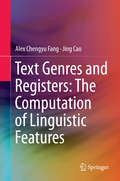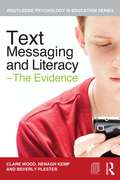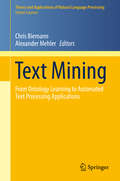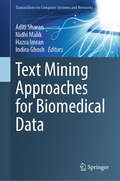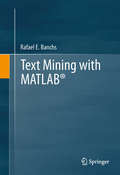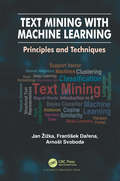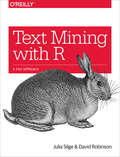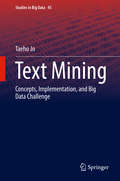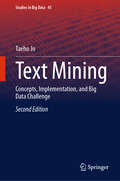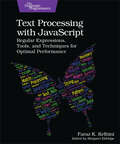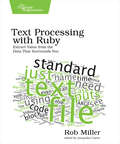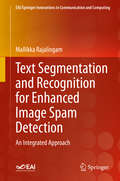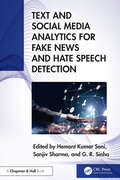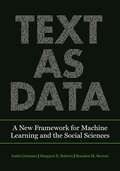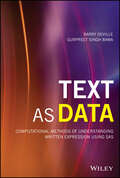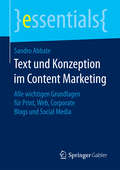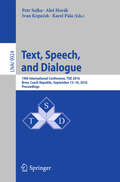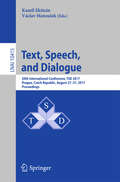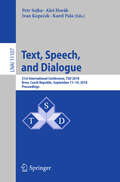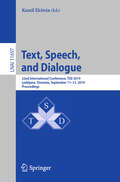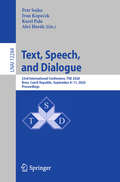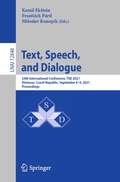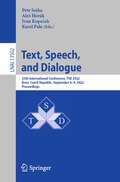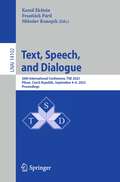- Table View
- List View
Text Genres and Registers: The Computation of Linguistic Features
by Alex Chengyu Fang Jing CaoThis book is a description of some of the most recent advances in text classification as part of a concerted effort to achieve computer understanding of human language. In particular, it addresses state-of-the-art developments in the computation of higher-level linguistic features, ranging from etymology to grammar and syntax for the practical task of text classification according to genres, registers and subject domains. Serving as a bridge between computational methods and sophisticated linguistic analysis, this book will be of particular interest to academics and students of computational linguistics as well as professionals in natural language engineering.
Text Messaging and Literacy – The Evidence
by Clare Wood Nenagh Kemp Beverly Plester"Well thought out and timely. This is the leading group in the world working on texting and literacy, and they have a strong track record of publications. It would also be the first book, as they say, to deal with the subject at an academic level. The focus on education is important, as this is where most of the anxieties lie. It will be a major step forward in creating a new climate." Professor David Crystal, author of The Cambridge Encyclopaedia of Language and The Cambridge Encyclopaedia of the English Language, Television consultant and presenter As children are given mobile phones at increasingly younger ages, there is considerable media coverage of claims that mobile phones, and text messaging in particular, are responsible for declining levels of literacy in children and young people. Such claims are often adopted wholesale by teachers and parents, despite the fact that there is an empirical literature which has failed to find a basis to these claims, and to the contrary has found that text messaging is supporting children’s literacy skills. Written by leading international researchers Text Messaging and Literacy presents an overview and discussion of the academic evidence for and against use of text messaging and mobile phones in supporting literate activity and discusses what conclusions we can and should draw about the impact of mobile phones, and their potential role in education. Areas covered include: the rise of texting and media reactions; children’s reading, spelling and texting; text messaging of children with language difficulties; using mobile phones for literacy development; texting and literacy skills in adolescents and adults; spelling and grammar in texting and beyond; the future of texting. In challenging existing assumptions the authors present the cutting edge of international research, highlighting their own studies involving children of all ages, adolescents and adults. This ground breaking book is essential reading for both researchers and students in education, educational psychology, literacy and new media and it’s impact on learning.
Text Mining
by Alexander Mehler Chris BiemannThis book comprises a set of articles that specify the methodology of text mining, describe the creation of lexical resources in the framework of text mining and use text mining for various tasks in natural language processing (NLP). The analysis of large amounts of textual data is a prerequisite to build lexical resources such as dictionaries and ontologies and also has direct applications in automated text processing in fields such as history, healthcare and mobile applications, just to name a few. This volume gives an update in terms of the recent gains in text mining methods and reflects the most recent achievements with respect to the automatic build-up of large lexical resources. It addresses researchers that already perform text mining, and those who want to enrich their battery of methods. Selected articles can be used to support graduate-level teaching. The book is suitable for all readers that completed undergraduate studies of computational linguistics, quantitative linguistics, computer science and computational humanities. It assumes basic knowledge of computer science and corpus processing as well as of statistics.
Text Mining Approaches for Biomedical Data (Transactions on Computer Systems and Networks)
by Aditi Sharan Nidhi Malik Hazra Imran Indira GhoshThe book 'Text Mining Approaches for Biomedical Data' delves into the fascinating realm of text mining in healthcare. It provides an in-depth understanding of how Artificial Intelligence (AI) and Machine Learning (ML) are revolutionizing healthcare research and patient care. The book covers a wide range of topics such as mining textual data in biomedical and health databases, analyzing literature and clinical trials, and demonstrating various applications of text mining in healthcare. This book is a guide for effectively representing textual data using vectors, knowledge graphs, and other advanced techniques. It covers various text mining applications, building descriptive and predictive models, and evaluating them. Additionally, it includes building machine learning models using textual data, covering statistical and deep learning approaches. This book is designed to be a valuable reference for computer science professionals, researchers in the biomedical field, and clinicians. It provides practical guidance and promotes collaboration between different disciplines. Therefore, it is a must-read for anyone who is interested in the intersection of text mining and healthcare.
Text Mining with MATLAB®
by Rafael E. BanchsText Mining with MATLAB provides a comprehensive introduction to text mining using MATLAB. It's designed to help text mining practitioners, as well as those with little-to-no experience with text mining in general, familiarize themselves with MATLAB and its complex applications. The first part provides an introduction to basic procedures for handling and operating with text strings. Then, it reviews major mathematical modeling approaches. Statistical and geometrical models are also described along with main dimensionality reduction methods. Finally, it presents some specific applications such as document clustering, classification, search and terminology extraction. All descriptions presented are supported with practical examples that are fully reproducible. Further reading, as well as additional exercises and projects, are proposed at the end of each chapter for those readers interested in conducting further experimentation.
Text Mining with Machine Learning: Principles and Techniques
by Jan Žižka František Dařena Arnošt SvobodaThis book provides a perspective on the application of machine learning-based methods in knowledge discovery from natural languages texts. By analysing various data sets, conclusions which are not normally evident, emerge and can be used for various purposes and applications. The book provides explanations of principles of time-proven machine learning algorithms applied in text mining together with step-by-step demonstrations of how to reveal the semantic contents in real-world datasets using the popular R-language with its implemented machine learning algorithms. The book is not only aimed at IT specialists, but is meant for a wider audience that needs to process big sets of text documents and has basic knowledge of the subject, e.g. e-mail service providers, online shoppers, librarians, etc. The book starts with an introduction to text-based natural language data processing and its goals and problems. It focuses on machine learning, presenting various algorithms with their use and possibilities, and reviews the positives and negatives. Beginning with the initial data pre-processing, a reader can follow the steps provided in the R-language including the subsuming of various available plug-ins into the resulting software tool. A big advantage is that R also contains many libraries implementing machine learning algorithms, so a reader can concentrate on the principal target without the need to implement the details of the algorithms her- or himself. To make sense of the results, the book also provides explanations of the algorithms, which supports the final evaluation and interpretation of the results. The examples are demonstrated using realworld data from commonly accessible Internet sources.
Text Mining with R: A Tidy Approach
by David Robinson Julia SilgeMuch of the data available today is unstructured and text-heavy, making it challenging for analysts to apply their usual data wrangling and visualization tools. With this practical book, you’ll explore text-mining techniques with tidytext, a package that authors Julia Silge and David Robinson developed using the tidy principles behind R packages like ggraph and dplyr. You’ll learn how tidytext and other tidy tools in R can make text analysis easier and more effective.The authors demonstrate how treating text as data frames enables you to manipulate, summarize, and visualize characteristics of text. You’ll also learn how to integrate natural language processing (NLP) into effective workflows. Practical code examples and data explorations will help you generate real insights from literature, news, and social media.Learn how to apply the tidy text format to NLPUse sentiment analysis to mine the emotional content of textIdentify a document’s most important terms with frequency measurementsExplore relationships and connections between words with the ggraph and widyr packagesConvert back and forth between R’s tidy and non-tidy text formatsUse topic modeling to classify document collections into natural groupsExamine case studies that compare Twitter archives, dig into NASA metadata, and analyze thousands of Usenet messages
Text Mining: Classification, Clustering, and Applications (Chapman & Hall/CRC Data Mining and Knowledge Discovery Series)
by Ashok N. Srivastava Mehran SahamiThe Definitive Resource on Text Mining Theory and Applications from Foremost Researchers in the FieldGiving a broad perspective of the field from numerous vantage points, Text Mining: Classification, Clustering, and Applications focuses on statistical methods for text mining and analysis. It examines methods to automatically cluster and classify te
Text Mining: Concepts, Implementation, and Big Data Challenge (Studies in Big Data #45)
by Taeho JoThis book discusses text mining and different ways this type of data mining can be used to find implicit knowledge from text collections. The author provides the guidelines for implementing text mining systems in Java, as well as concepts and approaches. The book starts by providing detailed text preprocessing techniques and then goes on to provide concepts, the techniques, the implementation, and the evaluation of text categorization. It then goes into more advanced topics including text summarization, text segmentation, topic mapping, and automatic text management.
Text Mining: Concepts, Implementation, and Big Data Challenge (Studies in Big Data #45)
by Taeho JoThis popular book, updated as a textbook for classroom use, discusses text mining and different ways this type of data mining can be used to find implicit knowledge from text collections. The author provides the guidelines for implementing text mining systems in Java, as well as concepts and approaches. The book starts by providing detailed text preprocessing techniques and then goes on to provide concepts, the techniques, the implementation, and the evaluation of text categorization. It then goes into more advanced topics including text summarization, text segmentation, topic mapping, and automatic text management. The book features exercises and code to help readers quickly learn and apply knowledge.
Text Processing with JavaScript
by Faraz K. KelhiniYou might think of regular expressions as the holy grail of text processing, but are you sure you aren't just shoehorning them in where standard built-in solutions already exist and would work better? JavaScript itself provides programmers with excellent methods for text manipulation, and knowing how and when to use them will help you write more efficient and performant code. From extracting data from APIs to calculating word counts and everything in between, discover how to pick the right tool for the job and make the absolute most of it every single time. Whether you're a beginner or an advanced programmer, this up-to-date guide will save you a ton of time when dealing with text. With Text Processing with JavaScript, you'll find a collection of tiny programs, each demonstrating a string manipulation approach in JavaScript. You'll also focus squarely on the practical aspects of text processing with JavaScript - that is, what each technique is designed to accomplish and how to use it in your program. Discover how to extract data from APIs and web pages, apply spelling corrections, convert and format currencies, and remove HTML tags from text. Learn to intersect tables, copy text to the clipboard, extract lists from text, and highlight sentences that contain a specific word. Find duplicate words and fix them automatically, modify a copy of an existing regex literal, match the beginning or end of a string, and remove all comments from JavaScript and HTML files with ease. Match non-ASCII words, calculate the word count of an article in any language, and more. Become a JavaScript expert and master chef of text processing with this collection of hands-on and production-ready recipes.
Text Processing with Ruby: Extract Value from the Data That Surrounds You
by Rob MillerText is everywhere. Web pages, databases, the contents of files--for almost any programming task you perform, you need to process text. Cut even the most complex text-based tasks down to size and learn how to master regular expressions, scrape information from Web pages, develop reusable utilities to process text in pipelines, and more.Most information in the world is in text format, and programmers often find themselves needing to make sense of the data hiding within. It might be to convert it from one format to another, or to find out information about the text as a whole, or to extract information fromit. But how do you do this efficiently, avoiding labor-intensive, manual work?Text Processing with Ruby takes a practical approach. You'll learn how to get text into your Ruby programs from the file system and from user input. You'll process delimited files such as CSVs, and write utilities that interact with other programs in text-processing pipelines. Decipher character encoding mysteries, and avoid the pain of jumbled characters and malformed output.You'll learn to use regular expressions to match, extract, and replace patterns in text. You'll write a parser and learn how to process Web pages to pull out information from even the messiest of HTML.Before long you'll be able to tackle even the most enormous and entangled text with ease, scything through gigabytes of data and effortlessly extracting the bits that matter.What You Need:This book requires a passing familiarity with the Ruby programming language, and assumes that you already have Ruby installed on your computer.
Text Segmentation and Recognition for Enhanced Image Spam Detection: An Integrated Approach (EAI/Springer Innovations in Communication and Computing)
by Mallikka RajalingamThis book discusses email spam detection and its challenges such as text classification and categorization. The book proposes an efficient spam detection technique that is a combination of Character Segmentation and Recognition and Classification (CSRC). The author describes how this can detect whether an email (text and image based) is a spam mail or not. The book presents four solutions: first, to extract the text character from the image by segmentation process which includes a combination of Discrete Wavelet Transform (DWT) and skew detection. Second, text characters are via text recognition and visual feature extraction approach which relies on contour analysis with improved Local Binary Pattern (LBP). Third, extracted text features are classified using improvised K-Nearest Neighbor search (KNN) and Support Vector Machine (SVM). Fourth, the performance of the proposed method is validated by the measure of metric named as sensitivity, specificity, precision, recall, F-measure, accuracy, error rate and correct rate. Presents solutions to email spam detection and discusses its challenges such as text classification and categorization;Analyzes the proposed techniques’ performance using precision, F-measure, recall and accuracy;Evaluates the limitations of the proposed research thereby recommending future research.
Text and Social Media Analytics for Fake News and Hate Speech Detection
by Hemant Kumar Soni, Sanjiv Sharma, and G. R. SinhaIdentifying and stopping the dissemination of fabricated news, hate speech, or deceptive information camouflaged as legitimate news poses a significant technological hurdle. This book presents emergent methodologies and technological approaches of natural language processing through machine learning for counteracting the spread of fake news and hate speech on social media platforms.• Covers various approaches, algorithms, and methodologies for fake news and hate speech detection.• Explains the automatic detection and prevention of fake news and hate speech through paralinguistic clues on social media using artificial intelligence.• Discusses the application of machine learning models to learn linguistic characteristics of hate speech over social media platforms.• Emphasizes the role of multilingual and multimodal processing to detect fake news.• Includes research on different optimization techniques, case studies on the identification, prevention, and social impact of fake news, and GitHub repository links to aid understanding.The text is for professionals and scholars of various disciplines interested in fake news and hate speech detection.
Text as Data: A New Framework for Machine Learning and the Social Sciences
by Justin Grimmer Margaret E. Roberts Brandon M. StewartA guide for using computational text analysis to learn about the social world From social media posts and text messages to digital government documents and archives, researchers are bombarded with a deluge of text reflecting the social world. This textual data gives unprecedented insights into fundamental questions in the social sciences, humanities, and industry. Meanwhile new machine learning tools are rapidly transforming the way science and business are conducted. Text as Data shows how to combine new sources of data, machine learning tools, and social science research design to develop and evaluate new insights.Text as Data is organized around the core tasks in research projects using text—representation, discovery, measurement, prediction, and causal inference. The authors offer a sequential, iterative, and inductive approach to research design. Each research task is presented complete with real-world applications, example methods, and a distinct style of task-focused research.Bridging many divides—computer science and social science, the qualitative and the quantitative, and industry and academia—Text as Data is an ideal resource for anyone wanting to analyze large collections of text in an era when data is abundant and computation is cheap, but the enduring challenges of social science remain.Overview of how to use text as dataResearch design for a world of data delugeExamples from across the social sciences and industry
Text as Data: Computational Methods of Understanding Written Expression Using SAS (Wiley and SAS Business Series)
by Barry DeVille Gurpreet Singh BawaText As Data: Combining qualitative and quantitative algorithms within the SAS system for accurate, effective and understandable text analytics The need for powerful, accurate and increasingly automatic text analysis software in modern information technology has dramatically increased. Fields as diverse as financial management, fraud and cybercrime prevention, Pharmaceutical R&D, social media marketing, customer care, and health services are implementing more comprehensive text-inclusive, analytics strategies. Text as Data: Computational Methods of Understanding Written Expression Using SAS presents an overview of text analytics and the critical role SAS software plays in combining linguistic and quantitative algorithms in the evolution of this dynamic field. Drawing on over two decades of experience in text analytics, authors Barry deVille and Gurpreet Singh Bawa examine the evolution of text mining and cloud-based solutions, and the development of SAS Visual Text Analytics. By integrating quantitative data and textual analysis with advanced computer learning principles, the authors demonstrate the combined advantages of SAS compared to standard approaches, and show how approaching text as qualitative data within a quantitative analytics framework produces more detailed, accurate, and explanatory results. Understand the role of linguistics, machine learning, and multiple data sources in the text analytics workflow Understand how a range of quantitative algorithms and data representations reflect contextual effects to shape meaning and understanding Access online data and code repositories, videos, tutorials, and case studies Learn how SAS extends quantitative algorithms to produce expanded text analytics capabilities Redefine text in terms of data for more accurate analysis This book offers a thorough introduction to the framework and dynamics of text analytics—and the underlying principles at work—and provides an in-depth examination of the interplay between qualitative-linguistic and quantitative, data-driven aspects of data analysis. The treatment begins with a discussion on expression parsing and detection and provides insight into the core principles and practices of text parsing, theme, and topic detection. It includes advanced topics such as contextual effects in numeric and textual data manipulation, fine-tuning text meaning and disambiguation. As the first resource to leverage the power of SAS for text analytics, Text as Data is an essential resource for SAS users and data scientists in any industry or academic application.
Text und Konzeption im Content Marketing: Alle wichtigen Grundlagen für Print, Web, Corporate Blogs und Social Media (essentials)
by Sandro AbbateIn diesem essential erfahren Sie alle wichtigen Grundlagen der Text- und Konzeptentwicklung f#65533;r eine Content-Marketing-Strategie. Der Autor beschreibt die erfolgsentscheidenden Stellschrauben, die Sie beachten m#65533;ssen und in die Sie ausreichend Zeit investieren sollten: von der vorab zu leistenden Denkarbeit, #65533;ber die strukturierte Konzeptentwicklung, bis hin zur optimalen Textarbeit f#65533;r Webtexte. Abgerundet wird dieser Band durch Interviews mit renommierten Experten und Erfolgsbeispielen aus der Praxis.
Text, Speech, and Dialogue
by Petr Sojka Aleš Horák Ivan Kopeček Karel PalaThis volume contains the Proceedings of the 7th International Conference on Text, Speech and Dialogue, held in Brno, Czech Republic, in September 2004, under the auspices of the Masaryk University. This series of international conferences on text, speech and dialogue has come to c- stitute a major forum for presentation and discussion, not only of the latest developments in academic research in these ?elds, but also of practical and industrial applications. Uniquely, these conferences bring together researchers from a very wide area, both intellectually and geographically, including scientists working in speech technology, dialogue systems, text processing, lexicography, and other related ?elds. In recent years the conference has dev- oped into aprimary meetingplacefor speech and languagetechnologistsfrom manydifferent parts of the world and in particular it has enabled important and fruitful exchanges of ideas between Western and Eastern Europe. TSD 2004 offered a rich program of invited talks, tutorials, technical papers and poster sessions, aswellasworkshops andsystemdemonstrations. Atotalof78paperswereaccepted out of 127 submitted, contributed altogether by 190 authors from 26 countries. Our thanks as usual go to the Program Committee members and to the external reviewers for their conscientious and diligent assessment of submissions, and to the authors themselves for their high-quality contributions. We would also like to take this opportunity to express our appreciation to all the members of the Organizing Committee for their tireless efforts in organizing the conference and ensuring its smooth running.
Text, Speech, and Dialogue: 20th International Conference, TSD 2017, Prague, Czech Republic, August 27-31, 2017, Proceedings (Lecture Notes in Computer Science #10415)
by Kamil Ekštein and Václav MatoušekThis book constitutes the proceedings of the 20th International Conference on Text, Speech, and Dialogue, TSD 2017, held in Prague, CzechRepublic, in August 2017.The 56 regular papers presented together with 3 abstracts of keynote talks were carefully reviewed and selected from 117 submissions. They focus on topics such as corpora and language resources; speech recognition; tagging, classification and parsing of text and speech; speech and spoken language generation; semantic processing of text and speech; integrating applications of text and speech processing; automatic dialogue systems; as well as multimodal techniques and modelling.
Text, Speech, and Dialogue: 21st International Conference, TSD 2018, Brno, Czech Republic, September 11-14, 2018, Proceedings (Lecture Notes in Computer Science #11107)
by Petr Sojka Aleš Horák Ivan Kopeček Karel PalaThis book constitutes the refereed proceedings of the 21st International Conference on Text, Speech, and Dialogue, TSD 2018, held in Brno, Czech Republic, in September 2018. The 56 regular papers were carefully reviewed and selected from numerous submissions. They focus on topics such as corpora and language resources, speech recognition, tagging, classification and parsing of text and speech, speech and spoken language generation, semantic processing of text and search, integrating applications of text and speech processing, machine translation, automatic dialogue systems, multimodal techniques and modeling.
Text, Speech, and Dialogue: 22nd International Conference, TSD 2019, Ljubljana, Slovenia, September 11–13, 2019, Proceedings (Lecture Notes in Computer Science #11697)
by Kamil EkšteinThis book constitutes the proceedings of the 22nd International Conference on Text, Speech, and Dialogue, TSD 2019, held in Ljubljana, Slovenia, in September 2019. The 33 full papers presented in this volume were carefully reviewed and selected from 73 submissions. They were organized in topical sections named text and speech. The book also contains one invited talk in full paper length.
Text, Speech, and Dialogue: 23rd International Conference, TSD 2020, Brno, Czech Republic, September 8–11, 2020, Proceedings (Lecture Notes in Computer Science #12284)
by Petr Sojka Aleš Horák Ivan Kopeček Karel PalaThis book constitutes the proceedings of the 23rd International Conference on Text, Speech, and Dialogue, TSD 2020, held in Brno, Czech Republic, in September 2020.*The 54 full papers presented in this volume were carefully reviewed and selected from 110 submissions. They were organized in topical sections named text, speech, and dialogue. The book also contains 3 invited talks.* The conference was held virtually due to the COVID-19 pandemic.
Text, Speech, and Dialogue: 24th International Conference, TSD 2021, Olomouc, Czech Republic, September 6–9, 2021, Proceedings (Lecture Notes in Computer Science #12848)
by Kamil Ekštein František Pártl Miloslav KonopíkThis book constitutes the proceedings of the 24th International Conference on Text, Speech, and Dialogue, TSD 2021, held in Olomouc, Czech Republic, in September 2021.*The 2 keynote speeches and 46 papers presented in this volume were carefully reviewed and selected from 101 submissions. The topical sections "Text", "Speech", and "Dialogue" deal with the following issues: speech recognition; corpora and language resources; speech and spoken language generation; tagging, classification and parsing of text and speech; semantic processing of text and speech; integrating applications of text and speech processing; automatic dialogue systems; multimodal techniques and modelling, and others. * Due to the COVID-19 pandemic the conference was held in a "hybrid" mode.
Text, Speech, and Dialogue: 25th International Conference, TSD 2022, Brno, Czech Republic, September 6–9, 2022, Proceedings (Lecture Notes in Computer Science #13502)
by Petr Sojka Aleš Horák Ivan Kopeček Karel PalaThis book constitutes the proceedings of the 25th International Conference on Text, Speech, and Dialogue, TSD 2022, held in Brno, Czech Republic, in September 2022. The 43 papers presented in this volume were carefully reviewed and selected from 94 submissions. The topical sections "Text", "Speech", and "Dialogue" deal with the following issues: speech recognition; corpora and language resources; speech and spoken language generation; tagging, classification and parsing of text and speech; semantic processing of text and speech; integrating applications of text and speech processing; automatic dialogue systems; multimodal techniques and modelling.
Text, Speech, and Dialogue: 26th International Conference, TSD 2023, Pilsen, Czech Republic, September 4–6, 2023, Proceedings (Lecture Notes in Computer Science #14102)
by Kamil Ekštein František Pártl Miloslav KonopíkThis book constitutes the refereed proceedings of the 26th International Conference on Text, Speech, and Dialogue, TSD 2023, held in Pilsen, Czech Republic, during September 4–6, 2023. The 31 full papers presented together with the abstracts of 3 keynote talks were carefully reviewed and selected from 64 submissions. The conference attracts researchers not only from Central and Eastern Europe but also from other parts of the world. One of its goals has always been bringing together NLP researchers with various interests from different parts of the world and promoting their cooperation. One of the ambitions of the conference is, not only to deal with dialogue systems but also to improve dialogue among researchers in areas of NLP, i.e., among the “text” and the “speech” and the “dialogue” people.
